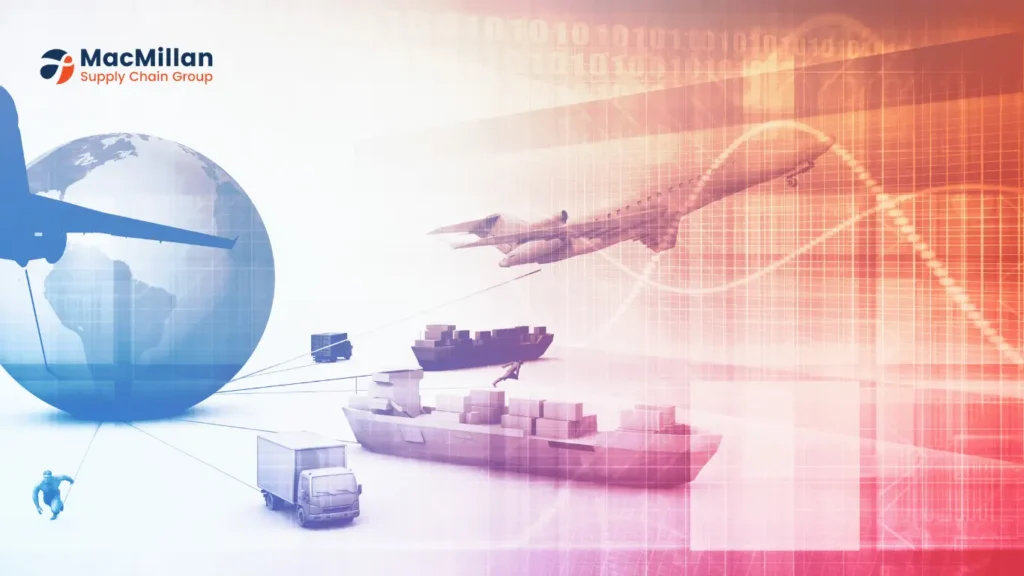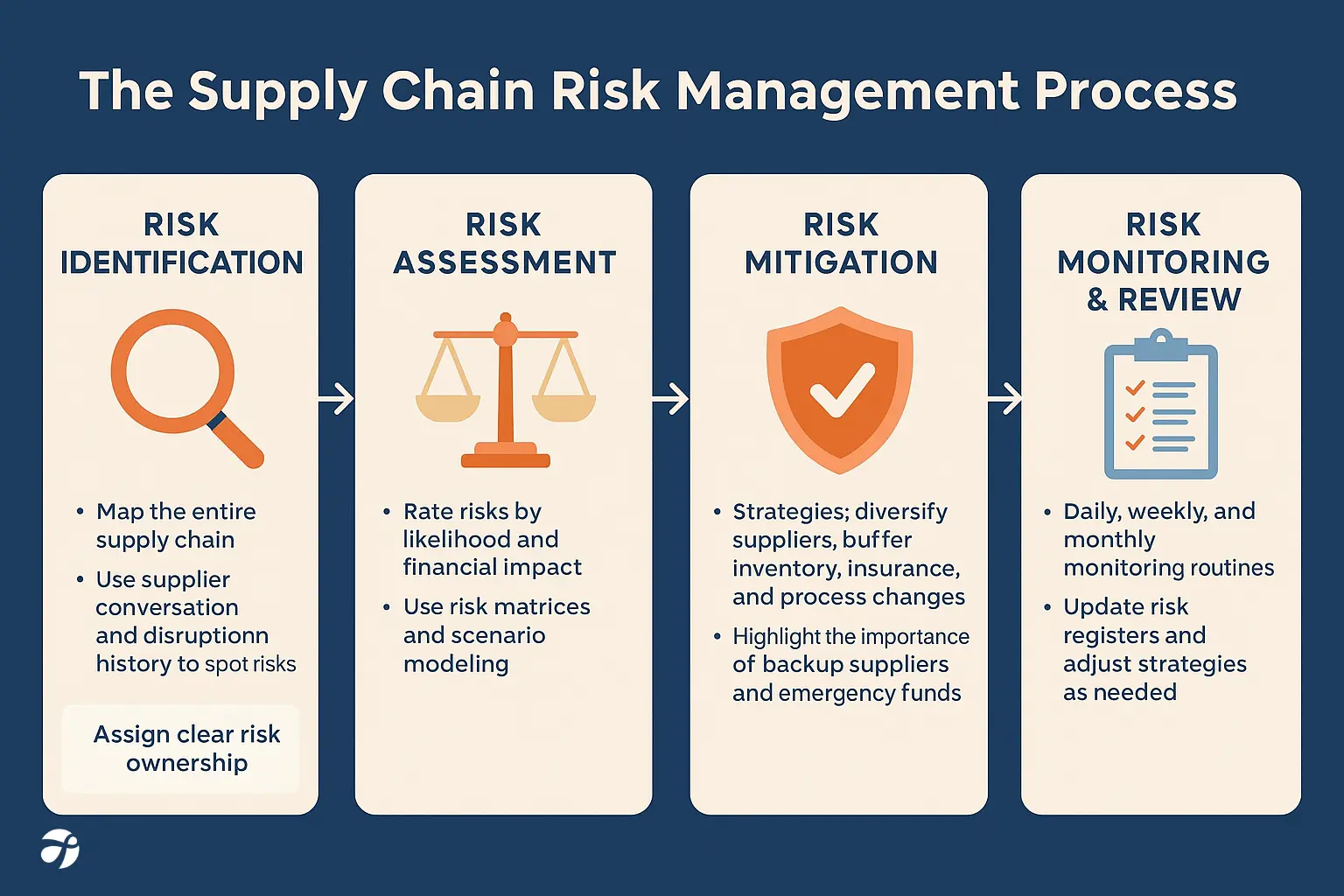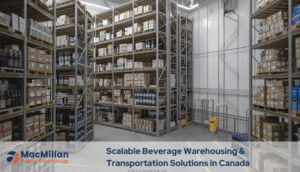Introduction
The world’s supply chains are more interconnected and vulnerable than ever in this age of rapid globalization. Geopolitical risks, which range from trade wars and sanctions to cyber threats and regional conflicts, are now a defining challenge for multinational corporations navigating geopolitical risks in global supply chain operations. For Canadian businesses, these risks are more than just news stories; they are actual, day-to-day challenges that have the potential to impair operations, raise expenses, and jeopardize business continuity.
We at Macmillan SCG have personally witnessed how these difficulties affect our clients. As a top Canadian supply chain provider, we help companies handle the challenges of international trade by running warehouses and providing last-mile delivery services all over the nation. The most important risks to Canadian supply chains, the changing geopolitical risk landscape, and tried-and-true methods for enhancing resilience in an unpredictable world will all be covered in this blog.
The New Geopolitical Reality: What’s Changed?
1. The Rise of Trade Wars and Tariffs
Growing trade tensions, especially between the US, China, and the EU, have made things unstable for importers and exporters since 2018. The cost structure of goods and raw materials can be abruptly altered by the imposition of tariffs. The implications for Canadian companies are substantial:
Unexpected cost increases: Some Canadian manufacturers have seen price increases of 10–40% as a result of steel, aluminum, and electronics tariffs.
Reconfiguring the supply chain forces businesses to reconsider their sourcing strategies; in order to avoid penalties, they frequently change suppliers or reroute shipments.
Regulatory uncertainty: The rules of the game can change with every new administration or international dispute.
2. Regional Conflicts and Disrupted Trade Routes
Regional conflicts can quickly block important shipping lanes, delay cargo, and raise insurance and security costs, as demonstrated by the Russia-Ukraine war and the unrest in the Middle East and Asia-Pacific. For instance:
In 2021, the blockage of the Suez Canal caused a daily delay of $9.6 billion in goods.
Ships were forced to reroute around Africa due to the Red Sea crisis in 2024, which resulted in longer delivery times and higher fuel prices.
The world’s semiconductor supply is under threat due to tensions in the Taiwan Strait, which affects everything from consumer electronics to automobiles.
These real-world disruptions emphasise the need for navigating geopolitical risks in global supply chain networks with greater agility.
3. Sanctions, Export Controls, and Compliance Headaches
Sanctions regimes are becoming more widespread, focusing on particular businesses, people, and even entire industries in addition to nations. Businesses in Canada have to negotiate a complicated web of:
restrictions on exporting sensitive technologies
prohibitions on sourcing from areas where human rights are violated
The US Uyghur Forced Labor Prevention Act (UFLPA), for example, requires evidence that products are not manufactured using forced labor
4. Digital Espionage and Cyberthreats
Supply chains are increasingly being targeted by state-sponsored hackers and cybercriminals as they digitize. The number of ransomware attacks on logistics companies grew by 300% in 2024 alone. Inventory systems can become paralyzed, sensitive data compromised, and operations halted for days or weeks due to a single breach.
5. Geopolitical Risks Associated with the Environment and Climate
With nations enacting carbon border taxes, limiting imports of high-emission goods, and calling for increased supply chain emissions transparency, climate change has become a geopolitical issue. This implies the following for Canadian exporters:
adjusting to the US and EU’s new carbon pricing plans
fulfilling more stringent environmental, social, and governance (ESG) reporting requirements
getting ready for “green trade wars,” in which sustainability is used as a weapon to compete
 The Canadian Viewpoint: Navigating Geopolitical Risks in Global Supply Chain
The Canadian Viewpoint: Navigating Geopolitical Risks in Global Supply Chain
Geographically, economically, and politically, Canada is unique, which presents a unique set of opportunities and challenges for our supply chains.
Strong reliance on international trade: Since the US accounts for more than 75% of Canadian exports, changes in US policy will have a significant impact on us.
Long, difficult supply chains: Because of our large geographic area and reliance on rail and maritime transportation, Canada is susceptible to infrastructure disruptions and chokepoints.
Diverse sourcing: A large number of Canadian businesses rely on international vendors for essential parts, ranging from Asia to Europe and Latin America.
We at Macmillan SCG have assisted clients in navigating these complexities across a variety of industries, from electronics and automotive to food and pharmaceuticals. Our experience demonstrates that although risks are present, they can be used as opportunities for growth if proactive measures are taken.
Significant Geopolitical Risks Affecting Canadian Supply Chains
1. Trade and Tariff Policy Volatility
Example: New regulations for labor, digital trade, and automotive content were introduced by the US-Mexico-Canada Agreement (USMCA/CUSMA), which superseded NAFTA.
Impact: Businesses were forced to invest in compliance systems, renegotiate contracts, and quickly modify their sourcing.
2. Export Controls and Sanctions
Example: Exports of specific metals, energy products, and technology were prohibited as a result of sanctions imposed on Russia in response to the conflict in Ukraine.
Impact: Due to shortages, Canadian manufacturers had to look for other suppliers, frequently at a higher cost.
3. Disruptions to Shipping Routes
Example: Carriers had to reroute around the Cape of Good Hope due to the Red Sea crisis in 2024, which extended shipments from Asia to North America by up to 20 days.
Impact: The requirement for greater safety stocks, higher shipping expenses, and inventory delays. These factors highlight why navigating geopolitical risks in global supply chain operations is now a strategic necessity.
4. ESG Regulations and Forced Labor
Example: New regulations in the US and the EU demand evidence that products are not produced using forced labor or in a way that violates environmental regulations.
Impact: Businesses need to invest in clear reporting systems, trace materials, and audit suppliers.
5. Cybersecurity Risks
Example: Ransomware attacks on logistics companies have the potential to stop operations, compromise data, and result in fines from the government.
Impact: Strong cybersecurity procedures, staff education, and incident response strategies are required.
Techniques for Navigating Geopolitical Risks in Global Supply Chain
1. Diversification Strategies for Navigating Geopolitical Risks in Global Supply Chain
Find substitute suppliers in other areas (the “China+1” approach)
Create multi-sourcing or dual-sourcing plans for essential parts
Reduce reliance on high-risk areas and open up new markets by utilizing our global network of partners
2. Regionalization and Nearshoring
Quicker and more dependable delivery to important markets
Lower emissions and expenses associated with transportation
Increased authority over compliance and quality
3. Adaptive Inventory Control
Keep an eye on global risk indicators, such as weather, strikes, and political instability
Adapt inventory levels instantly in response to new threats
To maintain continuity, distribute inventory among several warehouses in a strategic manner
4. Scenario Planning to Navigate Geopolitical Risks in Global Supply Chains
Dashboards for monitoring geopolitical risk in real time
Workshops on scenario planning to test supply chains
Blockchain and AI in supplier risk assessments
5. Regulatory Agility: A Key to Navigating Geopolitical Risks in Global Supply Chain
Automate trade documentation
Put ESG reporting systems into place
Prepare for environmental regulations such as carbon border taxes
6. Data Protection and Cybersecurity
All transportation and warehouse systems are encrypted to military standards
Employee training and routine penetration testing
Round-the-clock surveillance and prompt incident response
Technology’s Place in Geopolitical Risk Management
Predictive Analytics and Artificial Intelligence
Disruption forecasting: AI examines news, social media, and economic data to identify new threats
Route optimization: Shipments can be rerouted around weather events or conflict zones
Inventory optimization: AI forecasts increases or decreases in demand brought on by geopolitical developments
Blockchain Technology for Openness
Supplier audits: Blockchain offers unchangeable documentation of compliance, labor practices, and sourcing
Traceability: See everything from raw materials to final products, crucial for ESG compliance
IoT and Real-Time Tracking
IoT sensors keep tabs on the security, temperature, and location of cargo while it’s in transit
Early warning: Quick action is made possible by alerts for delays, detours, or tampering
The Method Used by Macmillan SCG to Create a Resilient Supply Chain
At Macmillan SCG, we think that resilience is about thriving in uncertainty rather than just surviving setbacks. Our all-encompassing strategy consists of:
Placement of warehouses strategically throughout North America and Canada
Last-mile delivery options that are flexible enough to adjust to new laws and routes
Cooperative alliances with carriers, suppliers, and tech companies
Ongoing development via frequent risk analyses and scenario preparation
 Future Trends: Navigating Geopolitical Risks in Global Supply Chain Over the Next Decade
Future Trends: Navigating Geopolitical Risks in Global Supply Chain Over the Next Decade
1. The Green Trade Wars
Anticipate increased carbon border taxes, sustainability regulations, and competition for green technologies as nations fight on climate policy.
2. Sovereignty of Digital
As countries assert more control over data, supply chains must abide by local cybersecurity and data storage regulations.
3. Shipping Routes in the Arctic
New trade routes through the Arctic are being made possible by melting ice, bringing with them both opportunities and new environmental and geopolitical risks.
4. Human Rights and Forced Labor
Global labor scrutiny will only increase, necessitating ethical sourcing and even greater supply chain transparency.
FAQs: Geopolitical Risk Management in the Supply Chain
Q1: What is the biggest geopolitical risk that Canadian supply chains are currently facing?
A: Although trade policy volatility, especially US tariffs and sanctions, remains the most immediate threat, worries about cyberattacks and ESG regulations are rapidly intensifying.
Q2: How can I strengthen my supply chain’s ability to withstand geopolitical shocks?
A: Use regional warehousing, invest in real-time risk monitoring, diversify your suppliers, and maintain proactive regulatory compliance.
Q3: Which technological advancements aid in geopolitical risk management?
A: The most important tools are IoT for real-time shipment tracking, blockchain for supplier transparency, and AI for predictive analytics.
Q4: How does Macmillan SCG assist customers in times of need?
A: To reduce interruption, we provide flexible warehousing, crisis response teams, round-the-clock risk monitoring, and quick shipment rerouting.
Conclusion: Creating Opportunities Out of Risk
Although navigating geopolitical risks in global supply chain environments is complex, Canadian businesses can not only survive but also prosper with the correct tactics. No matter what the world throws at our clients, we at Macmillan SCG are dedicated to helping them create supply chains that are flexible, robust, and prepared for the future.
Get in touch with Macmillan SCG right now for a personalized risk assessment and learn how we can assist you in navigating the challenges of international trade if you’re prepared to increase the resilience of your supply chain.
Follow us on LinkedIn for real-time tariff updates
FAQS
The primary geopolitical risks include trade wars and tariffs, regional conflicts disrupting shipping routes, sanctions and export controls, cyberattacks on supply chain systems, and evolving environmental regulations like carbon border taxes.
Businesses can diversify suppliers, nearshore production, implement dynamic inventory management, use AI-powered risk monitoring tools, and stay compliant with evolving trade and environmental regulations to build supply chain resilience.
Technology such as AI and predictive analytics helps forecast disruptions, blockchain ensures supplier transparency, and IoT devices provide real-time shipment tracking—enabling proactive risk management and faster response.
Macmillan SCG offers strategic warehousing, flexible last-mile delivery, AI-driven risk monitoring dashboards, scenario planning, and regulatory compliance support to help Canadian businesses mitigate geopolitical risks effectively.
Diversification reduces dependency on any single country or supplier, minimizing exposure to tariffs, sanctions, or regional disruptions, thereby ensuring continuity and flexibility in the supply chain.

 The Canadian Viewpoint: Navigating Geopolitical Risks in Global Supply Chain
The Canadian Viewpoint: Navigating Geopolitical Risks in Global Supply Chain Future Trends: Navigating Geopolitical Risks in Global Supply Chain Over the Next Decade
Future Trends: Navigating Geopolitical Risks in Global Supply Chain Over the Next Decade
